Statistics Report: Data Analysis, Trend Lines, and Forecasting
VerifiedAdded on 2022/12/28
|9
|1346
|20
Report
AI Summary
This report presents a comprehensive statistical analysis, beginning with a comparison of raw data and grouped data means, highlighting the impact of data organization on central tendency measures. It differentiates between nominal and ordinal data, emphasizing their distinct characteristics and applications. The report then contrasts the mean and median, elucidating their respective roles and appropriate uses in data analysis. Further, it delves into time series analysis, employing a quarter moving average model to identify trends in sales data. The analysis includes average seasonal variations, projected trend lines, and forecasted values. Finally, the report explores the factors influencing trend lines, such as international transactions, speculation, and supply and demand, providing a holistic understanding of the statistical concepts and their real-world implications.
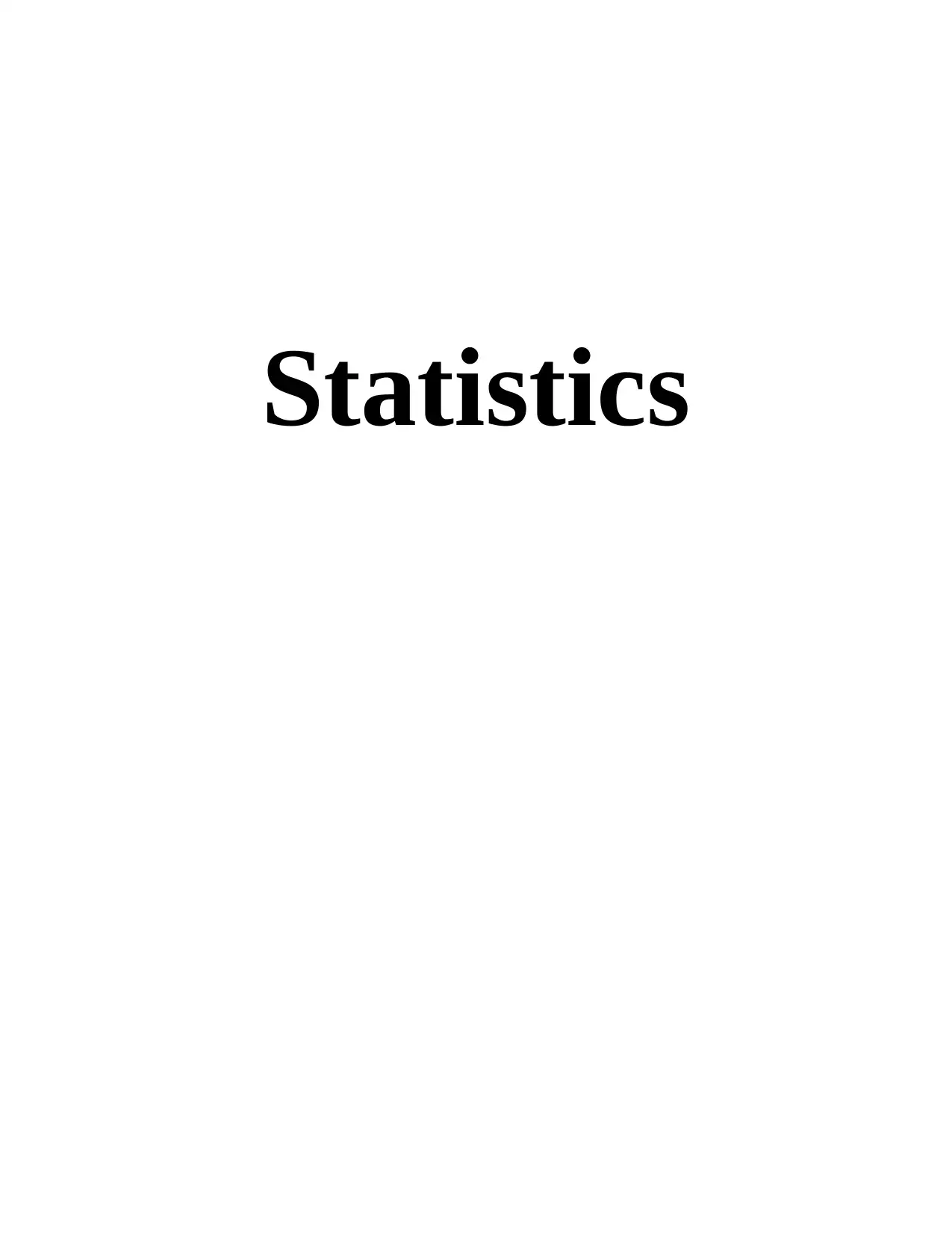
Statistics
Paraphrase This Document
Need a fresh take? Get an instant paraphrase of this document with our AI Paraphraser
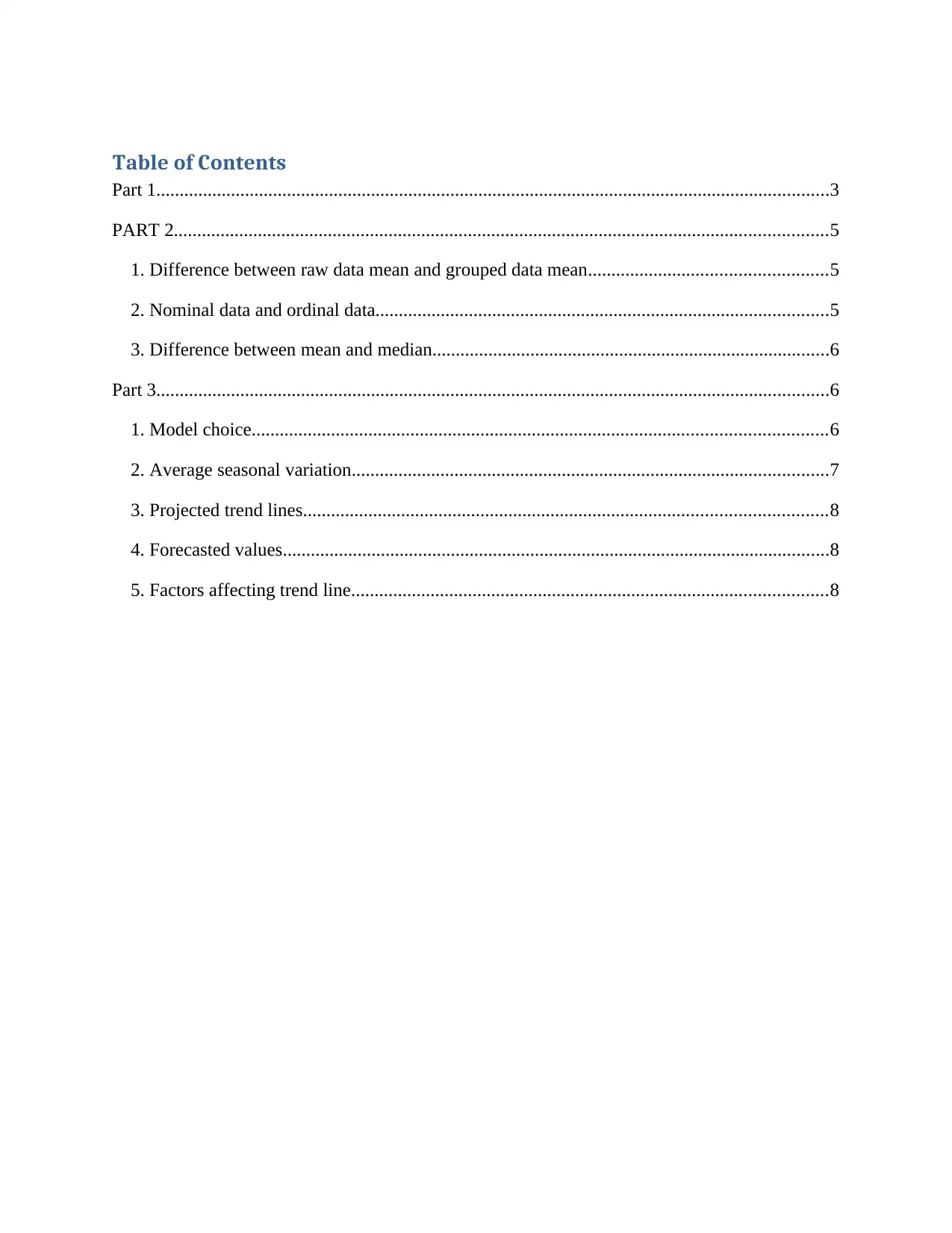
Table of Contents
Part 1................................................................................................................................................3
PART 2............................................................................................................................................5
1. Difference between raw data mean and grouped data mean...................................................5
2. Nominal data and ordinal data.................................................................................................5
3. Difference between mean and median.....................................................................................6
Part 3................................................................................................................................................6
1. Model choice...........................................................................................................................6
2. Average seasonal variation......................................................................................................7
3. Projected trend lines................................................................................................................8
4. Forecasted values.....................................................................................................................8
5. Factors affecting trend line......................................................................................................8
Part 1................................................................................................................................................3
PART 2............................................................................................................................................5
1. Difference between raw data mean and grouped data mean...................................................5
2. Nominal data and ordinal data.................................................................................................5
3. Difference between mean and median.....................................................................................6
Part 3................................................................................................................................................6
1. Model choice...........................................................................................................................6
2. Average seasonal variation......................................................................................................7
3. Projected trend lines................................................................................................................8
4. Forecasted values.....................................................................................................................8
5. Factors affecting trend line......................................................................................................8

Part 1
Raw data Mean = 9.815
Histogram
Frequenc
y
3 0
6 8
9 11
12 13
15 17
3 6 9 12 15 More
0
5
10
15
20
Histogram
Frequency
0
Frequency
The histogram above shows the data continuously increasing, where maximum customer spent
over £15 in an airplane café.
Raw data Mean = 9.815
Histogram
Frequenc
y
3 0
6 8
9 11
12 13
15 17
3 6 9 12 15 More
0
5
10
15
20
Histogram
Frequency
0
Frequency
The histogram above shows the data continuously increasing, where maximum customer spent
over £15 in an airplane café.
⊘ This is a preview!⊘
Do you want full access?
Subscribe today to unlock all pages.

Trusted by 1+ million students worldwide

Ogive
0 2 4 6 8 10 12 14 16
0
10
20
30
40
50
60
CF
CF
Median is at 25, where value median is ≈ 11
Q1 is at 12.5 customer, and value of Q1 ≈ 7.5
Q3 is at 37.5 customers, and the value of Q3 ≈ 13
X f Xf
3 0 0
6 8 48
9 11 99
12 13 156
15 17 255
49 558
Mean(x)
= ∑Xf/∑f
=
11.3877
6
Group Mean = 11.39
0 2 4 6 8 10 12 14 16
0
10
20
30
40
50
60
CF
CF
Median is at 25, where value median is ≈ 11
Q1 is at 12.5 customer, and value of Q1 ≈ 7.5
Q3 is at 37.5 customers, and the value of Q3 ≈ 13
X f Xf
3 0 0
6 8 48
9 11 99
12 13 156
15 17 255
49 558
Mean(x)
= ∑Xf/∑f
=
11.3877
6
Group Mean = 11.39
Paraphrase This Document
Need a fresh take? Get an instant paraphrase of this document with our AI Paraphraser

PART 2
1. Difference between raw data mean and grouped data mean
The logical reason behind this difference is round off figures, as in raw data case mean (9.815) is
calculated upto two digits; while in case of grouped data, mean (11.39) has been calculated
considering it as a whole number. Thus, due to this fact both mean sample are different.
The mean of grouped data is preferred because it is more accurate as compared to the mean of
ungrouped data. The mean of ungrouped data may lead to wrong manipulation of the median
therefore it is considered inefficient in most cases. Thus, manager should consider grouped data
mean.
2. Nominal data and ordinal data
Nominal data is defined as the data used to name or label variables that have no quantitative
meaning. Sometimes also referred to as "named" data, meaning derived from a nominal word.
Usually there is no internal website according to nominal data. For example, "Race" is a nominal
variable with multiple categories, but there is no specific way to rank it from highest to lowest or
vice versa.
Organizational data is a kind of organized category data. The variables in the organized data are
listed in an organized way. Ordered variables are usually numbered to indicate the order in the
list. However, numbers are not mathematically measured or defined, they are simply presented as
labels for evaluation.
Nominal data is a group of nonparametric variables and common data is a group of
nonparametric ordinal variables. Both are nonparametric variables, but are characterized by the
fact that ordinal data is sorted by rank. For example, it is very hot, it is hot, it is cold, it is very
cold, and it is hot. When viewed individually, they are all nominal values. However, if they are
rated and organized in a specific order (very hot, hot, hot, cold, very cold), they are considered
common data.
1. Difference between raw data mean and grouped data mean
The logical reason behind this difference is round off figures, as in raw data case mean (9.815) is
calculated upto two digits; while in case of grouped data, mean (11.39) has been calculated
considering it as a whole number. Thus, due to this fact both mean sample are different.
The mean of grouped data is preferred because it is more accurate as compared to the mean of
ungrouped data. The mean of ungrouped data may lead to wrong manipulation of the median
therefore it is considered inefficient in most cases. Thus, manager should consider grouped data
mean.
2. Nominal data and ordinal data
Nominal data is defined as the data used to name or label variables that have no quantitative
meaning. Sometimes also referred to as "named" data, meaning derived from a nominal word.
Usually there is no internal website according to nominal data. For example, "Race" is a nominal
variable with multiple categories, but there is no specific way to rank it from highest to lowest or
vice versa.
Organizational data is a kind of organized category data. The variables in the organized data are
listed in an organized way. Ordered variables are usually numbered to indicate the order in the
list. However, numbers are not mathematically measured or defined, they are simply presented as
labels for evaluation.
Nominal data is a group of nonparametric variables and common data is a group of
nonparametric ordinal variables. Both are nonparametric variables, but are characterized by the
fact that ordinal data is sorted by rank. For example, it is very hot, it is hot, it is cold, it is very
cold, and it is hot. When viewed individually, they are all nominal values. However, if they are
rated and organized in a specific order (very hot, hot, hot, cold, very cold), they are considered
common data.
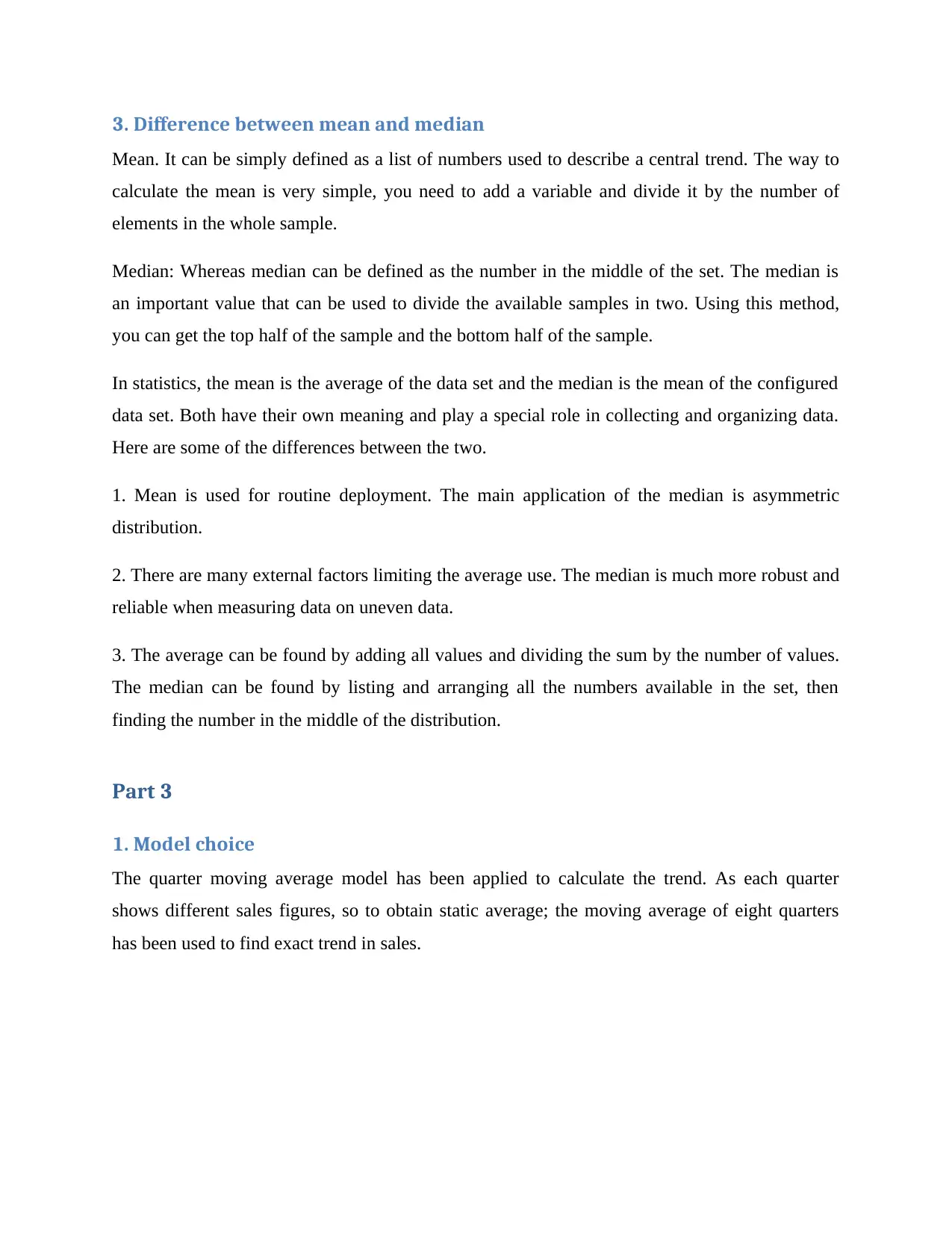
3. Difference between mean and median
Mean. It can be simply defined as a list of numbers used to describe a central trend. The way to
calculate the mean is very simple, you need to add a variable and divide it by the number of
elements in the whole sample.
Median: Whereas median can be defined as the number in the middle of the set. The median is
an important value that can be used to divide the available samples in two. Using this method,
you can get the top half of the sample and the bottom half of the sample.
In statistics, the mean is the average of the data set and the median is the mean of the configured
data set. Both have their own meaning and play a special role in collecting and organizing data.
Here are some of the differences between the two.
1. Mean is used for routine deployment. The main application of the median is asymmetric
distribution.
2. There are many external factors limiting the average use. The median is much more robust and
reliable when measuring data on uneven data.
3. The average can be found by adding all values and dividing the sum by the number of values.
The median can be found by listing and arranging all the numbers available in the set, then
finding the number in the middle of the distribution.
Part 3
1. Model choice
The quarter moving average model has been applied to calculate the trend. As each quarter
shows different sales figures, so to obtain static average; the moving average of eight quarters
has been used to find exact trend in sales.
Mean. It can be simply defined as a list of numbers used to describe a central trend. The way to
calculate the mean is very simple, you need to add a variable and divide it by the number of
elements in the whole sample.
Median: Whereas median can be defined as the number in the middle of the set. The median is
an important value that can be used to divide the available samples in two. Using this method,
you can get the top half of the sample and the bottom half of the sample.
In statistics, the mean is the average of the data set and the median is the mean of the configured
data set. Both have their own meaning and play a special role in collecting and organizing data.
Here are some of the differences between the two.
1. Mean is used for routine deployment. The main application of the median is asymmetric
distribution.
2. There are many external factors limiting the average use. The median is much more robust and
reliable when measuring data on uneven data.
3. The average can be found by adding all values and dividing the sum by the number of values.
The median can be found by listing and arranging all the numbers available in the set, then
finding the number in the middle of the distribution.
Part 3
1. Model choice
The quarter moving average model has been applied to calculate the trend. As each quarter
shows different sales figures, so to obtain static average; the moving average of eight quarters
has been used to find exact trend in sales.
⊘ This is a preview!⊘
Do you want full access?
Subscribe today to unlock all pages.

Trusted by 1+ million students worldwide
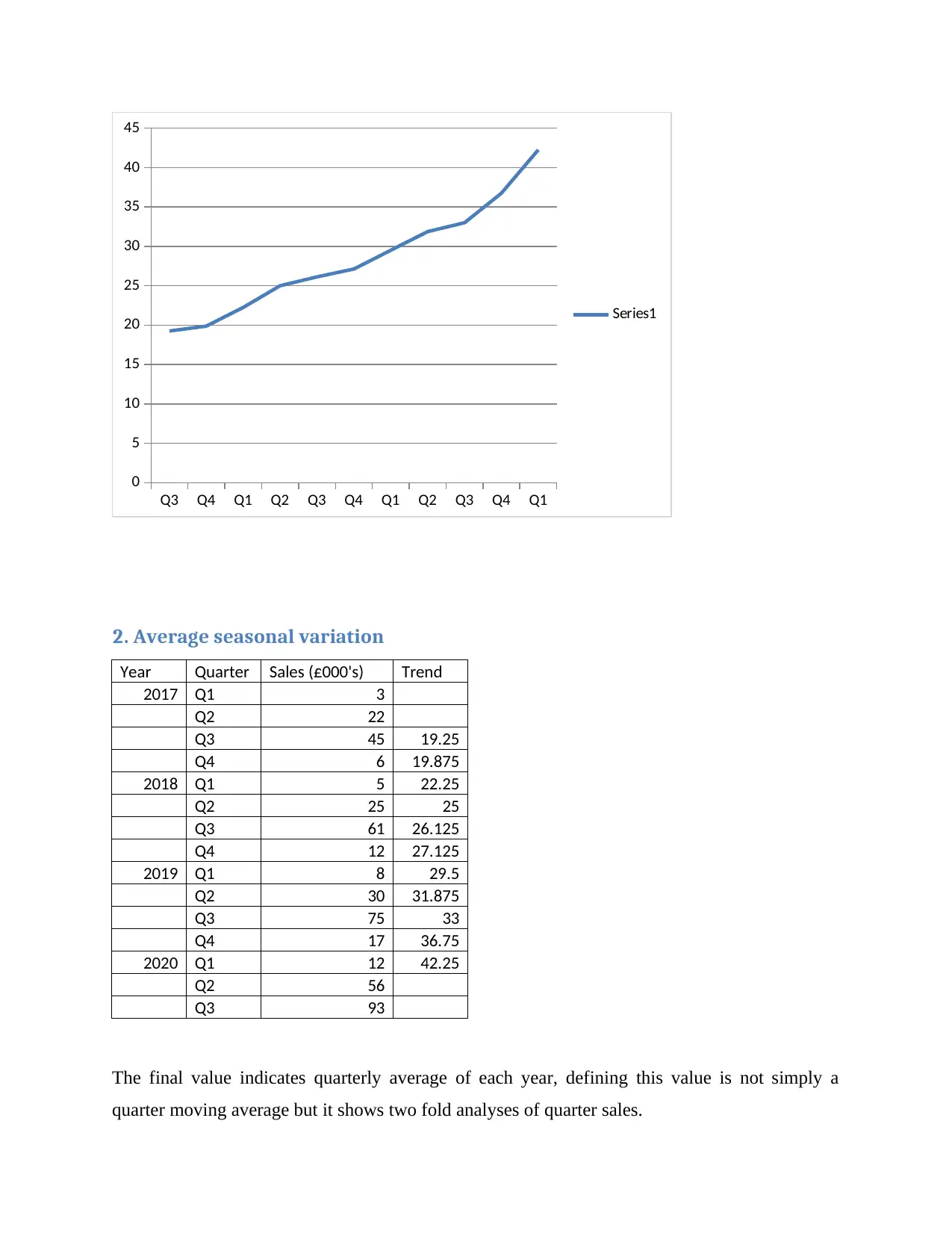
Q3 Q4 Q1 Q2 Q3 Q4 Q1 Q2 Q3 Q4 Q1
0
5
10
15
20
25
30
35
40
45
Series1
2. Average seasonal variation
Year Quarter Sales (£000's) Trend
2017 Q1 3
Q2 22
Q3 45 19.25
Q4 6 19.875
2018 Q1 5 22.25
Q2 25 25
Q3 61 26.125
Q4 12 27.125
2019 Q1 8 29.5
Q2 30 31.875
Q3 75 33
Q4 17 36.75
2020 Q1 12 42.25
Q2 56
Q3 93
The final value indicates quarterly average of each year, defining this value is not simply a
quarter moving average but it shows two fold analyses of quarter sales.
0
5
10
15
20
25
30
35
40
45
Series1
2. Average seasonal variation
Year Quarter Sales (£000's) Trend
2017 Q1 3
Q2 22
Q3 45 19.25
Q4 6 19.875
2018 Q1 5 22.25
Q2 25 25
Q3 61 26.125
Q4 12 27.125
2019 Q1 8 29.5
Q2 30 31.875
Q3 75 33
Q4 17 36.75
2020 Q1 12 42.25
Q2 56
Q3 93
The final value indicates quarterly average of each year, defining this value is not simply a
quarter moving average but it shows two fold analyses of quarter sales.
Paraphrase This Document
Need a fresh take? Get an instant paraphrase of this document with our AI Paraphraser
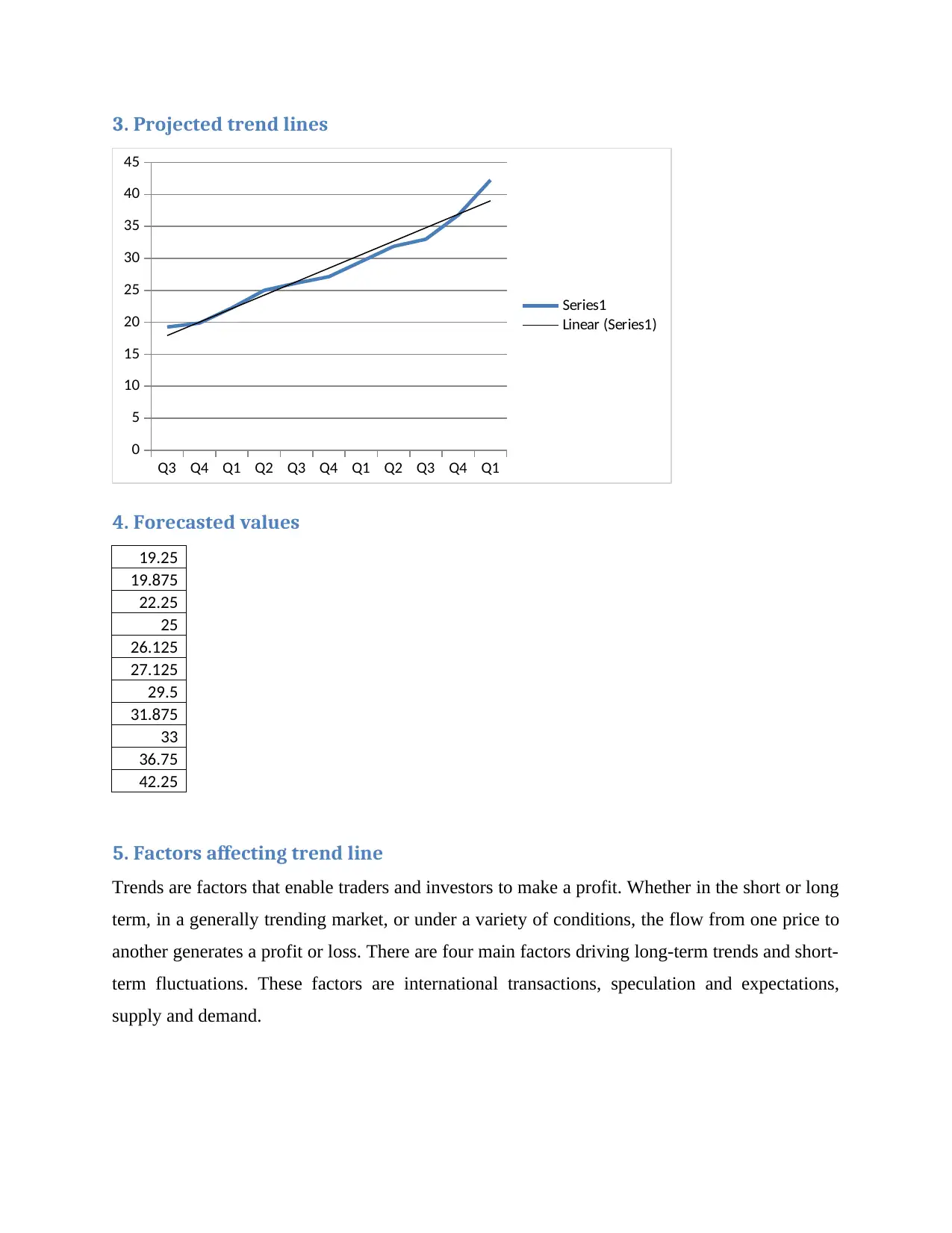
3. Projected trend lines
Q3 Q4 Q1 Q2 Q3 Q4 Q1 Q2 Q3 Q4 Q1
0
5
10
15
20
25
30
35
40
45
Series1
Linear (Series1)
4. Forecasted values
19.25
19.875
22.25
25
26.125
27.125
29.5
31.875
33
36.75
42.25
5. Factors affecting trend line
Trends are factors that enable traders and investors to make a profit. Whether in the short or long
term, in a generally trending market, or under a variety of conditions, the flow from one price to
another generates a profit or loss. There are four main factors driving long-term trends and short-
term fluctuations. These factors are international transactions, speculation and expectations,
supply and demand.
Q3 Q4 Q1 Q2 Q3 Q4 Q1 Q2 Q3 Q4 Q1
0
5
10
15
20
25
30
35
40
45
Series1
Linear (Series1)
4. Forecasted values
19.25
19.875
22.25
25
26.125
27.125
29.5
31.875
33
36.75
42.25
5. Factors affecting trend line
Trends are factors that enable traders and investors to make a profit. Whether in the short or long
term, in a generally trending market, or under a variety of conditions, the flow from one price to
another generates a profit or loss. There are four main factors driving long-term trends and short-
term fluctuations. These factors are international transactions, speculation and expectations,
supply and demand.
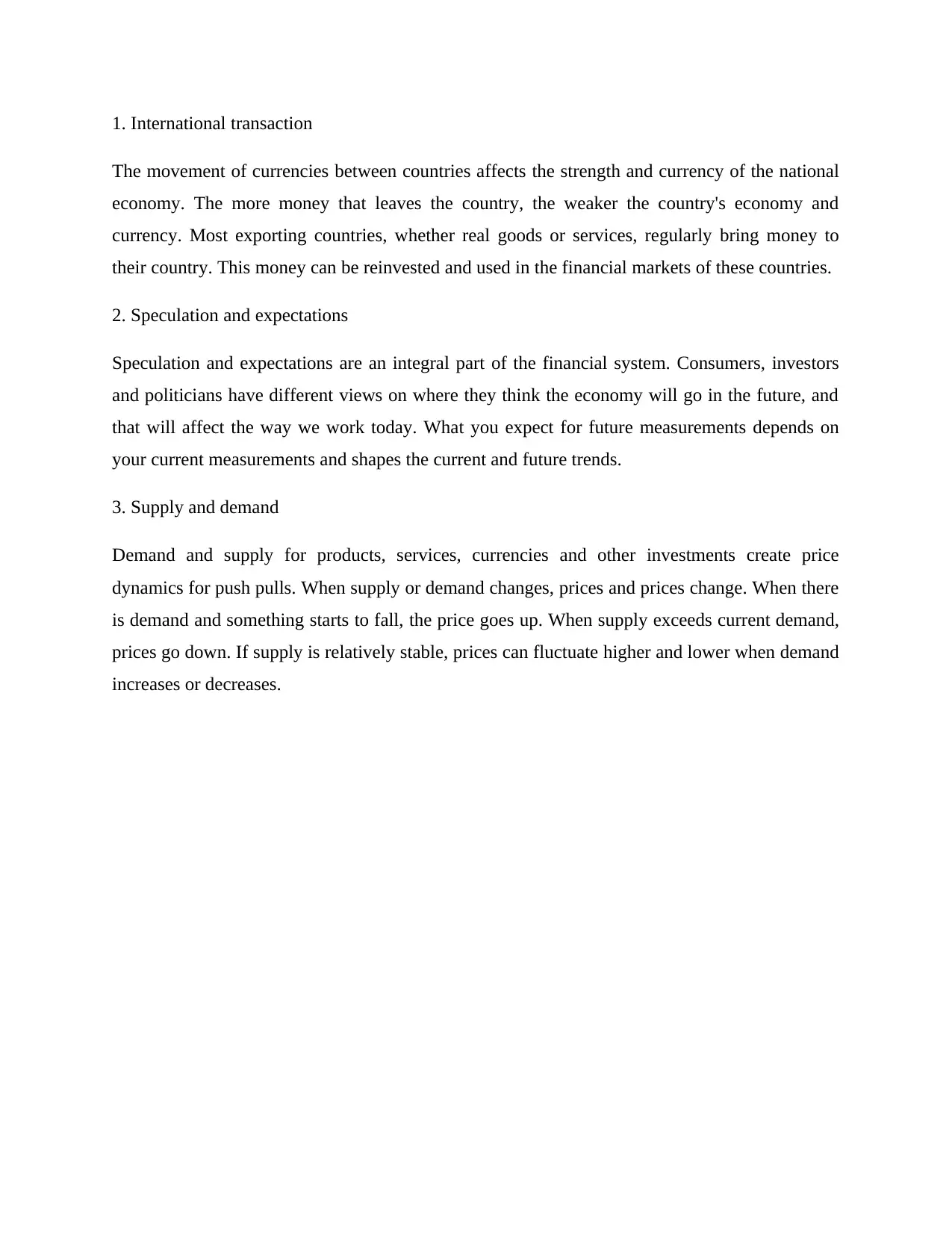
1. International transaction
The movement of currencies between countries affects the strength and currency of the national
economy. The more money that leaves the country, the weaker the country's economy and
currency. Most exporting countries, whether real goods or services, regularly bring money to
their country. This money can be reinvested and used in the financial markets of these countries.
2. Speculation and expectations
Speculation and expectations are an integral part of the financial system. Consumers, investors
and politicians have different views on where they think the economy will go in the future, and
that will affect the way we work today. What you expect for future measurements depends on
your current measurements and shapes the current and future trends.
3. Supply and demand
Demand and supply for products, services, currencies and other investments create price
dynamics for push pulls. When supply or demand changes, prices and prices change. When there
is demand and something starts to fall, the price goes up. When supply exceeds current demand,
prices go down. If supply is relatively stable, prices can fluctuate higher and lower when demand
increases or decreases.
The movement of currencies between countries affects the strength and currency of the national
economy. The more money that leaves the country, the weaker the country's economy and
currency. Most exporting countries, whether real goods or services, regularly bring money to
their country. This money can be reinvested and used in the financial markets of these countries.
2. Speculation and expectations
Speculation and expectations are an integral part of the financial system. Consumers, investors
and politicians have different views on where they think the economy will go in the future, and
that will affect the way we work today. What you expect for future measurements depends on
your current measurements and shapes the current and future trends.
3. Supply and demand
Demand and supply for products, services, currencies and other investments create price
dynamics for push pulls. When supply or demand changes, prices and prices change. When there
is demand and something starts to fall, the price goes up. When supply exceeds current demand,
prices go down. If supply is relatively stable, prices can fluctuate higher and lower when demand
increases or decreases.
⊘ This is a preview!⊘
Do you want full access?
Subscribe today to unlock all pages.

Trusted by 1+ million students worldwide
1 out of 9
Related Documents
Your All-in-One AI-Powered Toolkit for Academic Success.
+13062052269
info@desklib.com
Available 24*7 on WhatsApp / Email
![[object Object]](/_next/static/media/star-bottom.7253800d.svg)
Unlock your academic potential
Copyright © 2020–2025 A2Z Services. All Rights Reserved. Developed and managed by ZUCOL.





